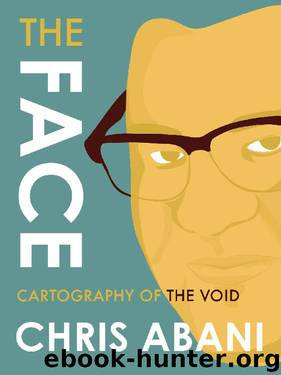The Face- Cartography of the Void by Chris Abani

Author:Chris Abani [Abani, Chris]
Language: eng
Format: epub
Tags: BIOGRAPHY & AUTOBIOGRAPHY / Cultural Heritage, BIO002000, BIOGRAPHY & AUTOBIOGRAPHY / Literary, BIO007000, BIOGRAPHY & AUTOBIOGRAPHY / Personal Memoirs, BIO026000, HISTORY / Africa / General, HIS001000, Science Fiction, Cuba, dystopia, cyberpunk, extraterrestrial invasion
ISBN: 9781632060143
Publisher: Restless Books
Published: 2015-04-02T07:00:00+00:00
The Terrain
It is dim in the museum in Auckland, New Zealand. Even dark, and moody. Light filters into this room in a hush, as if afraid to disturb something that lurks inside the shadows of the replica wharenui sitting in the middle of the room.
A wharenui (big house) or whare whakairo (carved house) is the focal point of a Maori marae, the communal space marked off for ritual and sacred ceremonies. Inside and outside of the wharenui are stylized carved images of the iwi, the tribe’s ancestors. But the wharenui is itself an ancestor too, perhaps the primordial founder of the tribe. I confess my knowledge here is limited, but if the wharenui is an ancestor, the koruru, or gable, at the front represents the head; the maihi, the diagonal baseboards, signify arms; the tahuhu, or the ridge beam, is the backbone; the heke, or rafters, signify ribs; and the central column inside, the poutokomanawa, is the heart.
I stand there and I don’t just breathe in the wood smell and the acridity of new wood polish; I am also reminded in this moment that all old cultures are more alike than not.
Here I stand before the Obuogo, the men’s sacred house at the center of the Ogo, in my hamlet of Amaha. It is the same principle, the same idea. Just as the wharenui is for the Maori, the Obuogo (the spiritual heart of the Ogo) is the center of the space of mystery and ancestral worship (Ogo), and the insides are lined with carved and sculpted ancestors. The two main differences are that Obuogos are made of mud walls built around wood frames with a raffia roof, and that the heart of the Obuogo is not a pillar but a room with an even smaller room inside it. The outer room houses the ancestral masks for the masquerades and other such paraphernalia and even, in some cases, the kamalu pots of the men, our ancestral lineage pots. The smaller room houses the secrets of Egbele and Okemma, the spirits that only the priests can know.
In the museum in Auckland, I reach out to the ancestral archetype closest to me. I am reminded of the role of this performative awe, which is to stress our links to both the living and the dead and to remind us that our identity is as much about the dead as it is about the living. In that mote-filled room I touch the ancestor’s carved wooden face. If the docent sees me, he makes no attempt to stop me. On this trip I have been frequently confused for a Maori, even by Maoris, and it has led to some tense moments.
The wood is surprisingly soft. And oily from the polish I smelled earlier. In Amaha, the faces are covered in oily soot from fires and palm oil and rituals I cannot reveal here.
My finger travels the longest carved line on the face, the thickest welt, up that face. From the base of the jaw all the way up the cheek, stopping just short of the abalone shell eye.
Download
This site does not store any files on its server. We only index and link to content provided by other sites. Please contact the content providers to delete copyright contents if any and email us, we'll remove relevant links or contents immediately.
| Actors & Entertainers | Artists, Architects & Photographers |
| Authors | Composers & Musicians |
| Dancers | Movie Directors |
| Television Performers | Theatre |
Cecilia; Or, Memoirs of an Heiress — Volume 2 by Fanny Burney(31869)
Cecilia; Or, Memoirs of an Heiress — Volume 3 by Fanny Burney(31852)
Fanny Burney by Claire Harman(26526)
We're Going to Need More Wine by Gabrielle Union(18967)
Plagued by Fire by Paul Hendrickson(17330)
All the Missing Girls by Megan Miranda(15564)
Cat's cradle by Kurt Vonnegut(15182)
Bombshells: Glamour Girls of a Lifetime by Sullivan Steve(13972)
Leonardo da Vinci by Walter Isaacson(13179)
For the Love of Europe by Rick Steves(12939)
4 3 2 1: A Novel by Paul Auster(12281)
Adultolescence by Gabbie Hanna(8857)
The remains of the day by Kazuo Ishiguro(8819)
Note to Self by Connor Franta(7620)
Diary of a Player by Brad Paisley(7487)
Giovanni's Room by James Baldwin(7189)
What Does This Button Do? by Bruce Dickinson(6134)
Ego Is the Enemy by Ryan Holiday(5293)
Born a Crime by Trevor Noah(5293)
